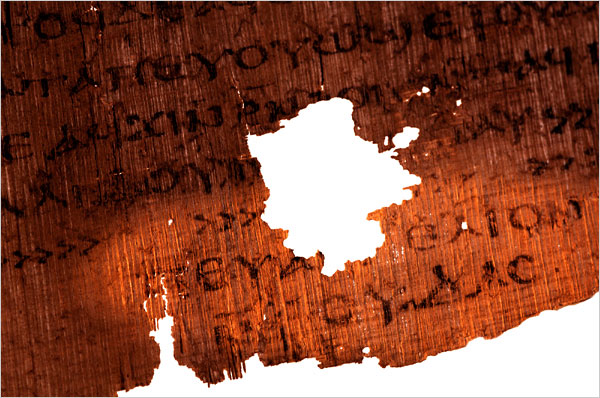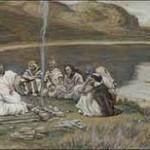Here are three good posts by my friend and colleague Larry Hurtado on all the hoopla about the Jesus’ wife fragments… see what you think… BW3
——-
Breaking News: Published Reports on “Jesus’ Wife” Fragment
by larryhurtado
I’ve just learned that the long-awaited reports on further analysis and scientific testing of the sensationalized “Jesus’ Wife” fragment (Coptic) have been published in the latest issue of Harvard Theological Review. The link is here, which will take you to the Harvard Divinity School site, and from there you’ll see a link to the HTR issue in question.
Included is the feature article by Karen King, a palaeographical analysis by Malcolm Choat, a characterization of the ink of the fragment by James T. Yardley and Alexis Hagadorn, articles on the application mass-spectrometry to the item, a ringing judgement (by Leo Depuydt) that the fragment is a forgery, followed by a point-by-point response by Karen King defending the authenticity of the item.
Let’s see now where the scholarly discussion goes. At last, we have something of substance to discuss!
——
“Jesus’ Wife” Articles in HTR: Initial Thoughts
by larryhurtado
From an initial (and rapid) reading of the articles in the latest issue of Harvard Theological Review about the “Jesus’ Wife” fragment, I’ll offer the following preliminary thoughts. (I had planned to pursue another project today, but an email early this a.m. alerting me to the HTR publications drew my attention to this “breaking” story.)
First, I’ll speak to Malcolm Choat’s preliminary observations about the fragment from a papyrological and palaeographical perspective. (Choat is a recognized figure in these matters, with special expertise in things Coptic.) I note that essentially Choat concludes that he wasn’t able to find “a smoking gun,” i.e., some clear indication of inauthenticity. I was particularly impressed with his note that there didn’t appear to be any ink-traces on the part(s) of the fragment that seem to have suffered damage. So, either the damage happened after the text was written, or else a supposed forger damaged the item after writing the text. I’d guess, personally, that the latter is somewhat less likely, but that’s a guess.
Choat also notes the curious nature of the hand and the way the ink was applied to the item. He judges the hand to be that of a copyist of very limited abilities (noting, e.g., the irregularities in letter-formation), and that the writer seems to have used a brush (anomalous for the putative period in question) or (as Bagnall suggested) a poorly trimmed reed-pen. As King now grants, the nature of the hand (and other factors) make it unlikely that the fragment comes from a codex and unlikely that the text functioned as a “gospel” liturgically. Instead, as she notes, it may be some kind of school exercise or perhaps even some kind of amulet-type item.
As for the scientific tests, those on the ink produce results consistent with the item being old, not modern. The two radio-carbon tests, however, are both a bit puzzling and interesting. The proposed dates of the two tests are out from each other by several hundred years. The one report (by Hodgins) notes the curious date-result (405-350 BCE and/or 307-209 BCE), about a thousand years earlier than the date from the other carbon-dating test (659-969 CE), and Hodgins suggests some kind of contamination of the sample. But I’d assume that a contamination would come from something later than the ancient setting, and so skew the date later, not earlier. I’ll need some help with this!
To come to Prof. King’s article (the main piece in the issue), I think she takes a careful line, seeking to defend her view that the item on balance seems authentic, but trying to take account of data that require some modification of her earlier judgements, and granting in the end that complete certainty is not possible. Prominent in the modifications of her earlier view is the intriguing statement in the appended note at the end of the article that the carbon-dating (taking the dating by Tuross) now seems to demand a date sometime in the 8th century CE (not the 4th/5th century CE dating in her earlier paper). As she notes, this takes us well into the Islamic period of Egypt, and so raises the question of whether, in fact, the fragment might reflect in some way the influence of Islamic ideas about Jesus.
Certainly, as Prof. King has rather consistently emphasized all along, whatever the date and provenance of the item, it has absolutely no significance whatsoever for “historical Jesus” studies. Contrary to some of the sensationalized news stories, that is, the fragment has no import for the question of whether Jesus was married.
Instead, she continues to propose that the fragment may reflect tensions and questions about marriage, celibacy, child-bearing, and gender that emerged in early Christianity in the early centuries (indeed, to judge from NT texts such as 1 Tim. 4:1-5; and even 1 Cor 7:1-7, questions of this nature emerged quite early). But, to repeat a point, the revised date for the papyrus (mid-8th century CE) introduces other factors to consider as well.
As to her suggestion that the Coptic text of the fragment might derive from a Greek original and that the latter might go back to the 2nd century, that (to my mind) cannot be taken as more than a possibility, and is certainly not required to account for the text.
Well, so much for now. I’ll be keen to see what other scholars now make of the matter.
——-
As a follow-up to my initial observations yesterday, I’ll offer a few more to underscore where I think things are at this point.
First, let me reiterate that all references to “The Gospel of Jesus’ Wife” are completely misleading tripe. What we have is a purported small fragment with several incomplete lines on each side, in which one line contains the words “my wife” ascribed to Jesus there. If the fragment is authentic (i.e., from some Christian hand ca. 7th-10th century CE, as per the Harvard radio-carbon test), only God knows what it was. But it’s totally mischievous to claim that it comes from some “Gospel of Jesus’ Wife”. We have a “Jesus’ Wife fragment.” That’s it.
The most recent palaeographical, chemical and radio-carbon tests reported in the latest issue of Harvard Theological Review support the conclusion that the writing material is old, that the ink seems composed per methods used in the putative date of the writing material, and that nothing definitive in the handwriting demands that it is a forgery. But, note well, Choat (Coptic palaeographer) also urges that his analysis doesn’t mean that it’s authentic, only that he hasn’t found clear evidence that it isn’t.
The major bases for allegations that the fragment is inauthentic have always been the contents, specifically, the Coptic expressions/phrasing. Francis Watson and others have alleged that it looks like a pastiche of Coptic phrases from Gospel of Thomas, and the alleged con-artist inadvertently included some errors in Coptic that betray his/her work. So, the focus of the debate has never been on things that could be settled by “scientific” tests. It will continue to be conducted on the basis of analysis of the contents (and perhaps a few other factors that I’m not free at this point to discuss).
Finally, as Prof. King and others have consistently indicated, even if authentic, the fragment would have no bearing on (1) the marital status of Jesus of Nazareth, (2) the question of women’s role in churches, (3) the question of Catholic priestly celibacy, etc. None whatsoever. Nada.
For recent responses to the HTR articles, see comments by Watson here, and by Christian Askeland here. As will be apparent from these, the debate is by no means over. So, the Harvard Divinity School press release “over-eggs” things in characterizing the tests as confirming authenticity of the fragment. Confirming the approximate age of the writing material is one thing, and confirming the authenticity of the writing on it is very much another thing!














